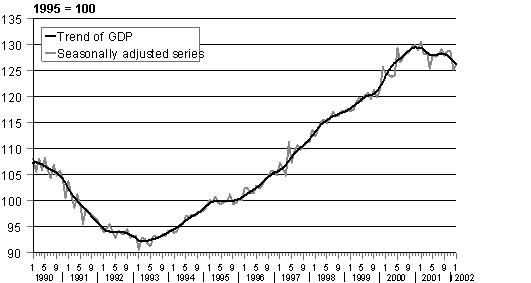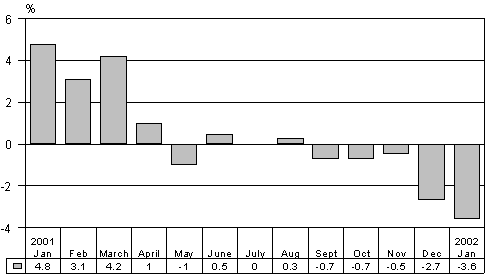27 March 2002
Inquiries: Mr Tuomas Rothovius +358 9 1734
3360, tuomas.rothovius@stat.fi
Director in charge: Mr Markku Suur-Kujala
GDP fell in January from the previous month
According to the trend of the Monthly Indicator of GDP calculated by Statistics Finland, the volume of GDP fell by 0.4 per cent in January from December. From February to June 2001 output always fell compared to the previous month, but in July the fall halted. According to the newest seasonally adjusted data, the trend has been declining again in the last few months.
Volume of GDP in 1990-2002, trend and seasonally adjusted series

The volume of GDP was 37 per cent higher in January 2002 than in March 1993 at the depth of the recession and 16 per cent higher than in December 1989 at the height of the economic boom before the recession.
The economic time series can be divided into trend cycle, seasonal variation and random variation components. When the seasonal variation component is removed from the original series of GDP, a seasonally adjusted series is obtained, the changes in which still vary greatly from the previous month. When the seasonally adjusted series is also adjusted for the random variation component, the trend cycle component describing more stable changes is left over. Seasonal variation and random variation components are removed with X11ARIMA models.
It should be noted that the series adjusted for seasonal and random variation will be revised along with new observations. The last three point figures of the trend cycle series should be taken with care because especially at the turning points new observations can significantly change the figures adjusted for seasonal and random variation.
GDP went down by 3.6 per cent from last year's January
In January 2002, GDP fell by 3.6 per cent from the previous year's January. Compared to January 2001, output fell in five of the six main industries, i.e. primary production, manufacturing, construction, trade and transport. The industries of public services and other services grew. According to revised data, total output declined from the previous year in December as well.
Percentage changes of GDP from the previous year's corresponding month

Output in agriculture and forestry fell by 7 per cent in January. Fellings contracted by 14 per cent. Milk production increased by 4 per cent and meat production by one per cent compared to January last year.
Industrial output as calculated per working day declined by 10 per cent in January from the year before. Calculated per working day, output in the manufacture of electrical products decreased by 23 per cent and in the wood and paper industry by 6 per cent. Energy supply increased by 3 per cent.
Output in trade reduced by nearly one per cent from January 2001. Within trade, sale volumes of retail trade were unchanged from last year's January. Sale of motor vehicles declined by 10 per cent and wholesale trade grew by 2 per cent.
Output in transport went down by half a per cent because rail transport decreased by 7 per cent. The volume of road transport was on level with last year's January. Post and telecommunications increased.
Output in other services and public services rose by nearly 2 per cent. Construction reduced by 2 per cent from January 2001.
The Monthly Indicator of GDP (total output) is based on twelve monthly series on different sectors of the economy. The series are summed up by weighting. The data were reviewed to correspond to the revised Volume Index of Industrial Output 2000=100. The effect of the index revision was taken into consideration in the 0.7 per cent change of gross domestic product indicated by the 2001 National Accounts preliminary data released at the end of February. The purpose of the Monthly Indicator is to anticipate the development of the volume of the quarterly gross domestic product published later.
Source: Monthly Indicator of GDP 2002, January. Statistics Finland
